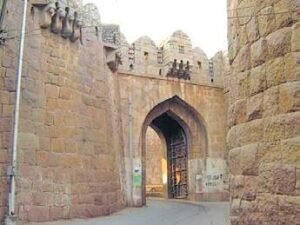Table of Contents
Golconda Fort, located in the western part of Hyderabad, Telangana, India, is a testament to the rich history and architectural brilliance of the region. The fort is renowned for its majestic structure, historical significance, and the fascinating stories that surround it. Golconda flourished as a trade centre of large diamonds known as Golconda Diamonds.

Early History and Construction
1143 AD: Golconda’s story begins when it was originally a mud fort under the reign of the Kakatiya dynasty, rulers of Warangal.
1364 AD: The fort came under the control of the Bahmani Sultanate.
1518 AD: After the decline of the Bahmani Sultanate, the fort became the seat of the Qutb Shahi dynasty. Sultan Quli Qutb-ul-Mulk, the founder of the Qutb Shahi dynasty, significantly strengthened and expanded the fort during his reign.
Expansion and Architectural Developments
16th Century: Under the Qutb Shahi rulers, Golconda Fort underwent extensive renovations and expansions. The Qutb Shahi kings built strong granite walls and numerous gates, turning Golconda into a massive fortification. The fort became the epicenter of the Qutb Shahi kingdom, known for its diamond trade and grandeur.
1600s: The architectural style of Golconda Fort is a blend of Hindu and Muslim styles, reflecting the cultural fusion of the Deccan region. The fort’s acoustic system is particularly notable – a clap at the entrance gate can be heard at the top of the fort, about a kilometer away. This was an early warning system for impending attacks.
Decline and Fall
1687 AD: The fort’s downfall began when it was besieged by Mughal Emperor Aurangzeb. After an eight-month-long siege, the fort was finally captured. The capture of Golconda marked the end of the Qutb Shahi dynasty and the fort’s significance as a political and military stronghold diminished.
Architectural Highlights
- Fateh Darwaza (Victory Gate): This is the main gate of the fort, named after Aurangzeb’s victorious entry.

Fateh Darwaza Golconda – deccanvoice.com
- Bala Hissar Pavilion: The highest point of the fort offers panoramic views of the surrounding area.

Bala Hissar Pavilion Golconda – deccanvoice.com
- Taramati Mosque and Premamati Mosque: Named after legendary courtesans, these structures showcase the intricate Persian-influenced architecture.

Taramati Mosque goldconda – deccanvoice.com

Premamati Mosque – golconda – deccanvoice
- Ramdas’ Prison: A small cell where Ramdas, a revenue official under the Qutb Shahi rulers, was imprisoned.

ramdan prison – golconda – deccanvoice
Modern-Day Golconda
Today, Golconda Fort is a popular tourist destination, attracting visitors from all over the world who come to marvel at its grandeur and delve into its historical narratives. The fort’s sound and light show brings its rich history to life, narrating the tales of the Qutb Shahi rulers and the fort’s glorious past.
Conclusion
Golconda Fort is not just an architectural marvel but also a symbol of the historical and cultural legacy of the Deccan region. From its early days as a mud fort to its zenith under the Qutb Shahi dynasty and eventual decline under the Mughals, Golconda stands as a silent witness to the tides of history that have swept through the region. Its walls, bastions, and ruins tell stories of ambition, power, and a bygone era of grandeur.








